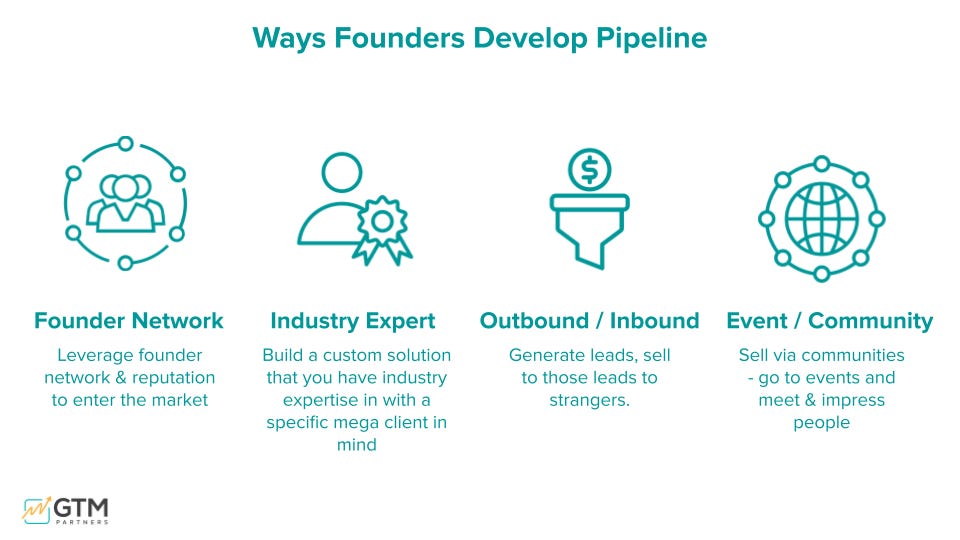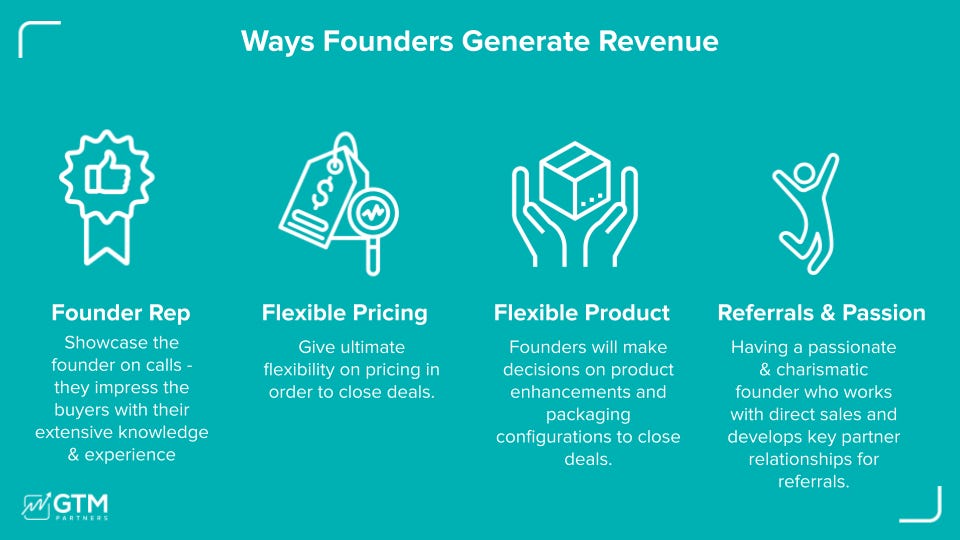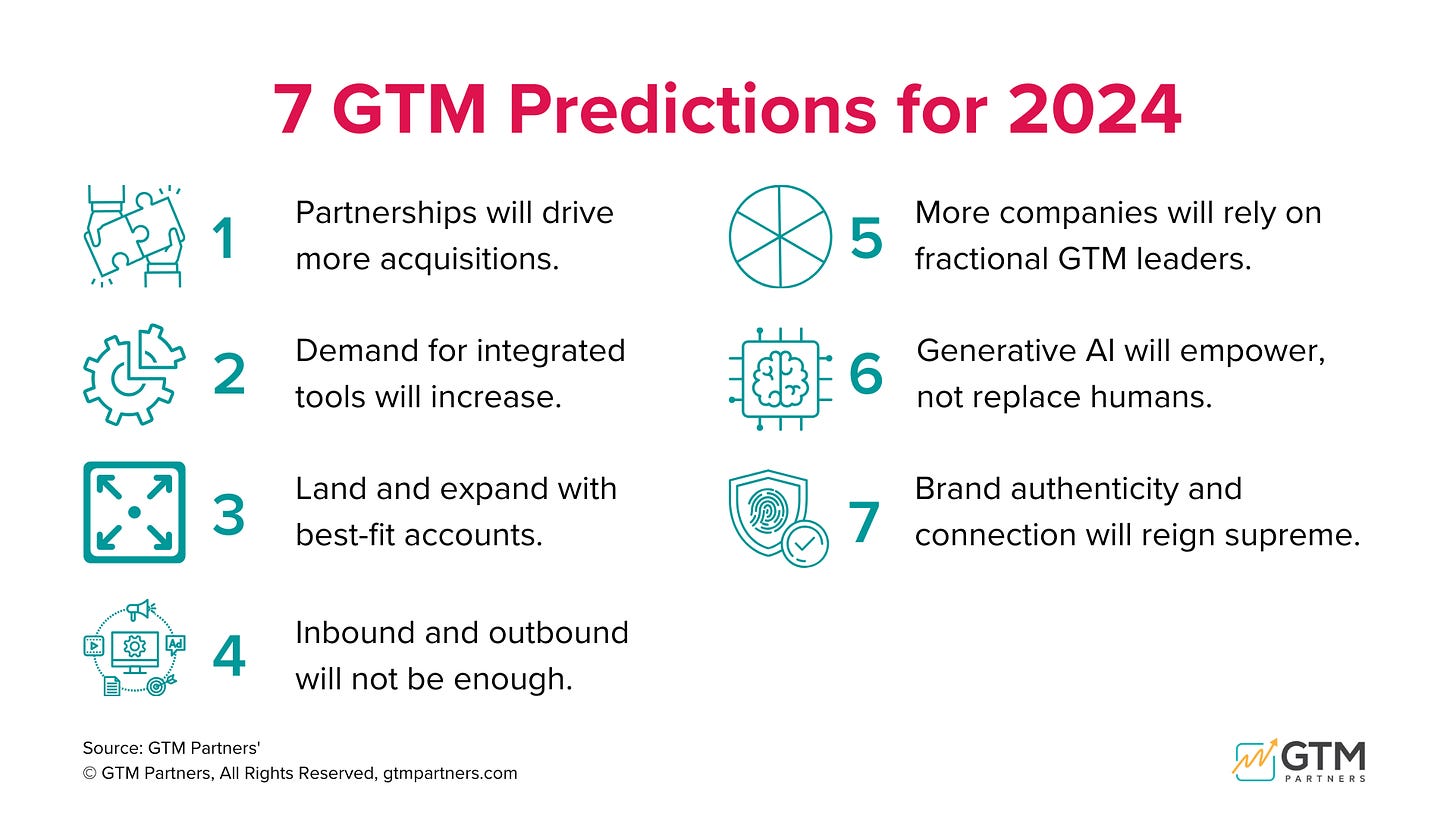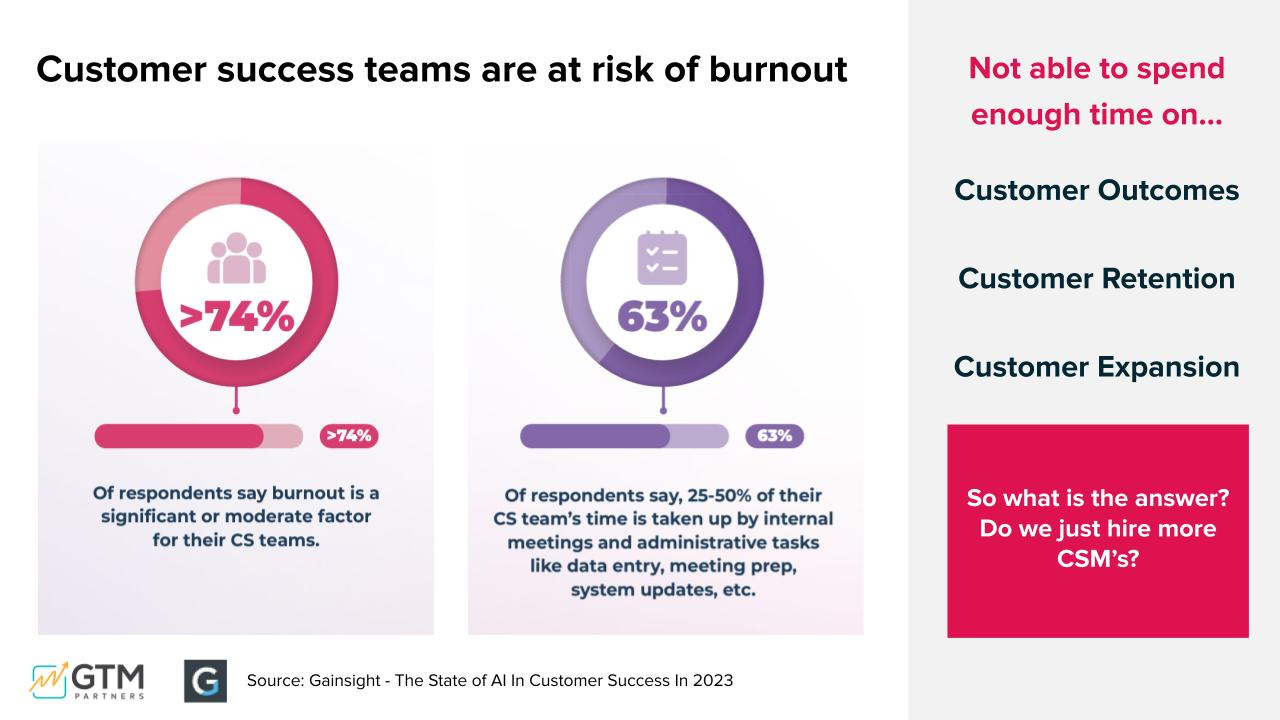Filters
Dear Founders, Here's how to get out of a founder-led sales motion . . .
There’s a lot of research on the benefits of founder-led culture:
Research from Reuters shows that the top 400 founder-led firms have registered an average share price gain of 58.4% compared to just a 10% return for the top 400 other companies.
According to Purdue University, S&P 500 companies where the founder is still CEO are more innovative, generate 31% more patents, create patents that are more valuable, and are more likely to make bold investments to renew and adapt the business model — demonstrating a willingness to take risk to invent the future.
Bain & Company found that the companies most successful at maintaining profitable growth over the long term were disproportionately companies where the founder was still running the business, sitting on the board, or where the focus and principles of how to operate that the founder had originally put in place still endured
Also from Bain: companies that maintain the founder’s mentality as they age are four to five times more likely to be top quartile performers. For instance, an index of S&P 500 companies in which the founder is still deeply involved performed 3.1 times better than the rest over the past 15 years.
Founder-led companies are great!
But founder-led SALES can be a drag, especially for the founders!
Most founders didn’t start a company because they love selling. They started it because they love solving a problem.
When founders are spending all their time on sales, they get exhausted and burned out. They also have less time to focus on the things that make founder-led companies great, namely:
Innovation and disruption
“Front-line obsession” (Bain’s term) with details and culture
An owner’s mindset of personal responsibility for risk and cost
Different Stages Call for Different Founder Plays
Sales needs to change and scale as a company does. Using the 3P model from Bryan and Sangram’s book, MOVE:
Problem-Market Fit
Earlier-stage companies at problem-market fit are going to need to rely on founder-led sales to some degree. There’s no way around it.
However, you can start to rely on complementary sales efforts.
Bring on less expensive reps who can run plays and processes with the style of the founder in mind. Let the founder do the razzle-dazzle in the meetings, but rely on sales assistants who can manage all the follow up and nurture.
Keep in mind that founders with a technical background will need different support than founders with a background in sales and marketing.
Product-Market Fit
When you reach product-market fit, you need to start thinking about bringing on a layer of sales leadership.
Leadership should oversee a small team of talented sellers, but the founder should still be heavily involved in training. Founders can also be brought in to close a deal or to get a higher-level economic buyer in the room.
At this stage, you start to segment by sales capabilities (for example, BDRs, SMB, mid-market, and enterprise reps).
Platform-Market Fit
Platform-market fit is the time for formal, scalable sales. If you try this approach too soon, you won’t succeed.
At this stage, you should build formal sales training, tracking, and enablement programs. Hire in numbers. Seek out a variety of sales skills to develop a well-rounded commercial team.
The founder may be brought in for very large, enterprise deals and to motivate the team at SKO.
Founder-Led Pipeline Development
Founders tend to develop pipeline in one of 4 ways:
1. Leverage the founder’s network and personal brand.
How it works today: The founder has access to people who are in market who will take a chance on the solution because it serves a need AND they trust the founder to be successful due to experience.
How to scale:
Focus on building partner relationships with key partners who will support the sale.
Land with high influence brands to encourage aspirational engagement.
Active thought leadership program to create inbound.
Formalize your social media pipeline generation plan (assuming they have an active social media presence).
Pitfall: Founder can’t eject too quickly - they will tag team prospect engagement through multiple mediums.
2. Custom build for a specific client or industry
How it works today: Because of specialized or industry experience, the founder builds a customized solution for one big potential client. The hope is to scale that solution to help other organizations.
How to scale:
Find standardizable components of the product (software, process, service, experience). Start to build a segmentation and value structure that can be placed in campaigns.
Go deep into your initial industry and build a reputation for excellence.
Get customer testimonials and case studies on your value.
Pitfall: Make sure testimonials avoid talking about non-scalable skills (e.g. “They did everything we wanted.” “They have amazing customer service.” “They do incredible custom work.”)
3. Traditional Inbound and Outbound
How it works today: Founders that don’t have a strong personal brand but do have a fantastic, easily understood product don’t need to leverage personal relationships. They can generate leads and execute sales with strangers via traditional inbound and outbound methods.
How to scale:
Score current pipeline fit and adjust to ensure the highest-value customers are being targeted by integrated marketing programs.
Consider partners as options for getting more traction with the right audiences.
Pitfall: Don’t boil the ocean by going after every company that could conceivably buy your product/service. Think Total Relevant Market (TRM) instead of Total Addressable Market (TAM).
4. Events and Community
How it works now: The founder is coast to coast, attending every industry event and earning millions of airline miles to meet people in-market, generate leads, and build the brand.
How to scale:
Train and deputize thought leaders you trust to represent the company, message, and value.
If you’re strong in one vertical or location, expand to more.
Develop thought leadership talk tracks for events inspired by the founder that others can deliver with passion.
Hire people for other roles (sales, marketing, product, CS) comfortable at events, talking with strangers and driving meetings.
Pitfall: Founders can spend a lot of time making a new presentation and talk track for every event, but don’t be afraid to be repetitive in market. People will not remember! Be disciplined with your time and your message. Don’t just go anywhere you’re invited, don’t do every podcast, don’t attend every trade show. Make sure the audience is right in terms of industry, authority, and need.
Closing the Deal
Founders do more than just generate pipeline. They are essential to closing the deal.
Most founders will be able to extricate themselves from pipeline development much sooner than they can get out of closing.
Even founders of billion dollar public companies with complex, scaled sales departments and many layers of management are still often involved in closing large, enterprise deals.
1. If you have relied on the founder’s reputation and network to close deals . . .
How it works now: Showcase the founder on calls and allow them to impress the buyers with extensive knowledge and experience. Make the buyer feel like they are working with someone who quickly understands and solves their issues.
How to scale:
Teach sellers the triggers that will inspire someone to make a change.
Find ways of sharing founder knowledge through books, videos, and content that is easier to scale than one-on-one time with the founder.
Have the founder publicly tout the brilliance of individuals on their teams to transfer some of the founder authority to those trusted resources.
Elevate other executives to a public stage, giving them speaking opportunities, thought leadership lanes of expertise, and a robust social media presence.
Hold the founder back to close higher value deals. Use a sales motion that puts some mystique around the founder involvement. Make access feel special.
Pitfall: Training the market to expect the founder to come in to close all deals at the end. Make sure customers have ways to interact with the founder in groups if connection to that personality is a huge value.
2. If you have relied on flexible pricing to close deals . . .
How it works now: Smaller, founder-led orgs can often offer flexibility in pricing that larger companies can’t. In the early days of a company the founder has the ability to make or approve these deals on the fly, allowing customers to take a chance on you and banking on lifetime value to make the contract worthwhile.
How to scale:
Create guidelines to allow that flexibility to exist in the sales cycle without the extreme authority of a founder.
Create a fast approval for changes to be made on the fly.
Modular pricing makes it easy for a sales person to get to a price that closes the deal by adjusting deliverables and end value.
Make sure sales know what is “hard” for the delivery team and what is a “no brainer” so they can throw in freebies or added value that doesn’t overtax resources.
Create a culture of forgiveness for overselling/over discounting so that reps feel safe executing on deals.
Pitfall: If your seller is allowed to make significant concessions, ensure the entire GTM is aware and on board so that heroic sales efforts don’t overtax the team.
3. If you have relied on a flexible product . . .
How it works now: As a start-up, one advantage you have is the ability to quickly change your product to suit the needs of the buyer. Founders are typically very close to the solution and can make snap decisions to add features or functionality that will close a deal.
How to scale:
Analyze how much of your success has come from saying “yes” to off-the-cuff client needs during a sales process. If it is significant, build guidelines for sellers that allow them to quickly get answers on product customizations during sales cycles.
Make sure product teams understand sales goals and GTM strategy so they don’t see requests that close deals as spurious and unnecessary.
When a deal does close as the result of a proffered product enhancement, give credit and praise to the talented product team that will deliver.
4. If you have relied on referrals and customer passion
How it works now: You’re getting deals from partner and customer referrals who love the passion of the founder and want to be a part of the story.
How to scale:
Work with customers and referrers to scale a program that can be leveraged by more than just the founder.
Organize ambassadors, customer stories, referral programs, etc.
Make it valuable for others to promote your solution.
So Founders, What is Your Next Move?
Hopefully this research note has demonstrated that we feel your pain!
At GTM Partners, we ourselves have a founder-led sales motion, and we know better than anyone how hard it can be.
We are still at a stage and size where it’s necessary, but we know it won’t be forever.
And we’ve made some small changes that support Sangram’s sales efforts, even if we can’t totally take it off his plate yet.
On that note, if you’re interested in working with GTM Partners or finding out more about how we help customers demonstrate ROI, fix common GTM problems, and achieve efficient growth, book a meeting with Sarah below!
Your first meeting will be with her, and then Sangram joins the conversation if necessary down the road. (How’s that for transparency in our sales motion?!)
We will be taking two weeks off from GTMonday: December 25 and January 1 because we have some great new research coming out and we don’t want anyone to miss it!
Have a healthy and happy holiday break with your family and friends.
Love,
GTM Partners




